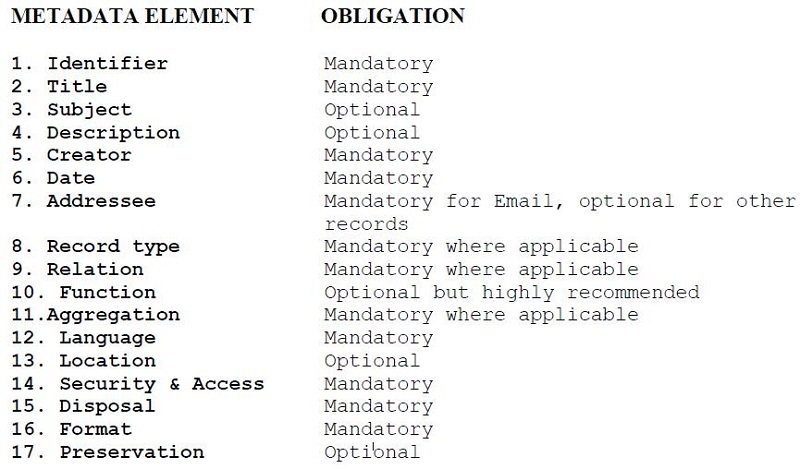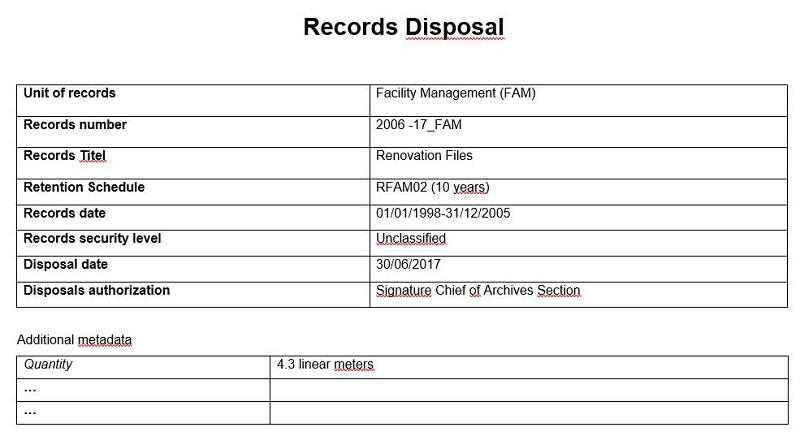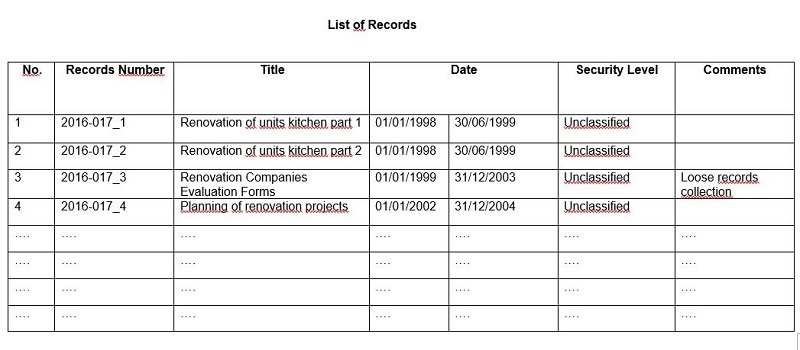Metadata standards in international archives
The UN recognised the need for a professional archives and records management early and, two decades ago, founded the Archives and Records Management Section (ARMS). The metadata standard developed by ARMS is essential for the development of tools for the workflow of handling records.
1. Genesis of archive and records management in the United Nations
Working with metadata standards in international archives or records management sections is essential for their professional management and workflow. The UN-Headquarter in New York, founded in 1945, acknowledged the necessity to manage its records and, two decades ago, founded the professional Archives and Records Management Section known as ARMS, which was also designated to provide and support other international organizations of the UN with guidelines.1In Europe, younger organizations of the UN are located in Switzerland, Austria and Germany.2 In the last decade, several of them acknowledged the need to establish an archives and/or records management section.
2. Standards and Policies of ARMS
In 2007, the UN-Secretary General Ban Ki Moon released the Secretary-General’s bulletin “Record-keeping and the management of United Nations archives” (ST/SGB/2007/5)3 as well as the bulletin “Information sensitivity, classification and handling” (ST/SGB/2007/6)4 in order to legitimize a professional archives and records management in the UN and its organizations. Subsequently, ARMS developed several important guidelines for the implementation of professional workflows, such as the Common File Classification Scheme5developed in 2011, and the Retention Schedule6 as drafts for workflows for single processes like records transfer and disposals.7 But because archive and records management had already been implemented in the UN earlier, ARMS, facing the challenge of electronic records management, developed its “Standard on Recordkeeping Metadata”8 in 2004.
3. The Standard on Recordkeeping Metadata 2004
The “Standard on Recordkeeping Metadata” stated: “This Standard describes the metadata that the United Nations Archives and Records Management Section (ARMS) recommends should be captured in recordkeeping systems used in all United Nations offices. Compliance with this Recordkeeping Metadata Standard will help UN offices to identify, authenticate, describe and manage their electronic records in a systematic and consistent way to meet business, accountability and archival requirements.” Metadata was interpreted as “descriptive information" in a records keeping system. The purpose of the standard was “that UN offices should capture in a structured way to describe the identity, authenticity, content, structure, context and essential management requirements of records. Such descriptive information will enable reliable, accurate and accessible records to be accessible through time as a means of satisfying business needs, evidential requirements and broader community expectations. United Nations offices are required to carry out their business in an accountable, transparent and efficient manner. ARMS has developed this Standard to document metadata requirements that apply to all United Nations records“.9
The aim of ARMS was to include „mandatory and optional descriptive elements“. It included 17 metadata elements, which have been classified as essential for records keeping. 12 of 17 elements were classified as mandatory, 5 as optional. The metadata appear as a scheme10.
This standard metadata is essential for the development of necessary archival and records management’s tools, e.g. the creation sheets for records disposal.

4. From theory to practice: a form for records disposal process
UN archives and records management sections usually work with paper based standard sheets for documentation, created by Word or Excel. Referring to the standard metadata, it is possible to draft a standard operating sheet for documentation, in this case of a disposal of records. It can be drafted by referring to the metadata standard element 15.

A drafted form of an analogue disposal sheet referring to the ARMS metadata on authors’ experience should exist on two main metadata schemes.
No. 1) metadata for the disposal as a process itself on the front page
No. 2) metadata of the list of all records designed for disposal as annex
No. 1) shall contain the metadata:
1) Unit of records (metadata element number 5) 2) Records Number as signature (metadata element number 1) 3) Records Title (metadata element number 2) 4) Retention Schedule (metadata 15 subelement 1) 5) Records date (metadata element number 6) 6) Records security level (metadata element number 15)
7) Disposals date (metadata 15 subelement 6)
8) Disposals authorization with signature (metadata 15 subelement 7) The result is the drafted form:

Of course every archive or records management unit can add much more optional metadata.
For records disposal, every record needs to be listed as annex. So No. 2) shall contain the metadata:
1) Running number for each single records container (binder, folder, box)
2) Records number (metadata element number 1)
3) Records title (metadata element number 2)
4) Records date (metadata element number 6)
5) Records security level (metadata element number 15)
6) Comments (recommended)
The result is the drafted form:

Of course there is the possibility to fill the list form with further additional metadata.
5. Situation
The ARMS metadata standard, as well as its referring guidelines, is more than a proposal; it is an essential requirement for establishing the necessary tools for a professional archive and records management environment in an international organization like the UN. This metadata development as part of the workflow will certainly be improved on in the future, considering the upcoming specific requirements in the field of digitization and database preservation. Metadata is indispensable for the archivist’s profession.
- 1 Compare https://archives.un.org/
- 2 For an overview of the location of UN Organizations compare URL:http://www.un.org/en/sections/...
- 3 Secretary-General’s bulletin “Record-keeping and the management of United Nations archives” from 12 February 2007 (ST/SGB/2007/5), compare URL:https://archives.un.org/sites/...
- 4 Secretary-General’s bulletin “Information sensitivity, classification and handling” from 12th February 2007 (ST/SGB/2007/6), compare URL:https://archives.un.org/sites/...
- 5 File Classification Scheme for Administrative Functions Common to all UN Offices from June 2012, Compare URL: https://archives.un.org/sites/...
- 6 Compare https://archives.un.org/conten...
- 7 Compare https://archives.un.org/conten...
- 8 Standard on Recordkeeping Metadata, United Nations Archives and Records Management Section (ARMS) CAS/FCSD/OCSS, Department of Management, 2004, 37 p., Compare URL:https://archives.un.org/sites/...
- 9 Comp. 8), p. 4-9.
- 10 Comp. 8), p. 10.
Résumé
- English
- Français
- Deutsch
Metadata standards for international archives or records management sections like the organizations of the UN are required to establish the necessary tools for the workflow. The UN has already developed a standard metadata scheme for the business activities of its organizations, including optional and mandatory metadata, to professionally process the lifecycle of records in the international environment.
Les normes de métadonnées pour les services d’archives ou de records management des organisations internationales de l’ONU sont un pré-requis à l’établissement d’outils de gestion des flux de travail. L’ONU a développé à l’intention de ses organes un schéma de métadonnées - facultatives et obligatoires - pour ses activités afin de traiter le cycle de vie de l’information dans un environnement international.
Für internationale Archive oder Records Management Bereiche, wie die Organisationen der UNO, sind Metadaten Standards unumgänglich für die Entwicklung notwendiger Workflow-Hilfsmittel. Die UNO hat bereits ein Standard Metadaten Schema für die Geschäftstätigkeit ihrer Organisationen entwickelt, einschliesslich fakultativer wie auch vorgeschriebener Metadaten, um den Lebenszyklus der Akten in einem internationalen Umfeld professionell verwalten zu können.

